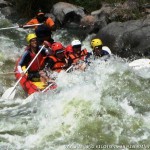Uncategorized
now browsing by category
The International Scale of River Difficulty – know what you are paddling

Every weekend hundreds of people descend on our rivers for an adrenaline experience, looking for the biggest rapids & grades. But do you know what you are getting yourself into? Read more on the Grades you are paddling:
International Scale of River Difficulty
The International Scale of River Difficulty is a standardized scale used to rate the safety of a stretch of river, or a single (sometimes whitewater) rapid. The grade reflects the technical difficulty and skill level required associated with the section of river. (taken from APA Operating Standards)
Grade I
Fast moving water with riffles and small waves. Few obstructions, all obvious and easily missed with little training. Risk to swimmers is slight; self-rescue is easy.
Grade II
Straightforward rapids with wide, clear channels which are evident without scouting. Occasional manoeuvring may be required, but rock and medium-sized waves are easily missed by trained paddlers. Swimmers are seldom injured and group assistance while helpful, is seldom needed. Rapids that er at the upper end of this difficulty range are designated a Class II+
Grade III
Rapids with moderate irregular waves which may be difficult to avoid and which can swamp an open canoe. Complex manoeuvres in fast current and good boat control in tight passages or around ledges are often required; large waves or strainers may be present but are easily avoided. Strong eddies and powerful current effects can be found, particularly on large-volume rivers, scouting is advisable for inexperienced parties. Injuries while swimming are rare; self-rescue is usually easy but group assistance may be required to avoid long swims. Rapids that are at the lower of upper end of this difficulty range are designated Class III- or Class III+ respectively.
Grade IV
Intense, powerful but predictable rapids requiring precise boat handling in turbulent water. Depending on the character of the river, it may feature large, unavoidable waves and holes or constricted passages demanding fast manoeuvres under pressure. A fast reliable eddy turn may be needed to initiate manoeuvres, scout rapids, or rest. Rapids may require ‘must’ moves above dangerous hazards. Scouting may be necessary the first time down. Risk of injury to swimmers is moderate to high, and water conditions may make self-rescue difficult. Group assistance for rescue is often essential but requires practiced skills. A strong kayak roll is highly recommended. Rapids that are at the lower or upper end of this difficulty range are designated Class IV- of Class IV+ respectively. Limit of open top canoes.
Grade V
Extremely long, obstructed, or very violent rapids which expose a paddler to added risk. Drops may contain large, unavoidable waves and holes or steep, congested chutes with complex, demanding routes. Rapids may continue for long distances between pools, demanding a high level of fitness. What eddies exist may be small, turbulent, or difficult to reach. At the high end of the scale, several of these factors may be combined. Scouting is recommended but may be difficult. Swims are dangerous, and rescue is often difficult, even for experts. A very reliable kayak roll, proper equipment, extensive experience, and practical rescue skills are essential. Because of the large range of difficulty that exist beyond Class IV, Class V is an open-ended, multiple-level scale disgnated by class 5.0, 5.1, 5.2, etc… each of these levels is an order of magnitude more difficult than the last. Example: increasing difficulty from Class 5.0 to Class 5.1, is a similar order of magnitude increasing from Class IV to Class 5.0.
Grade VI
These runs have almost never been attempted and often exemplify the extremes of difficulty, unpredictability and danger. The consequences of errors are very severe and rescue may be impossible. For teams of experts only, at favourable water levels, after close personal inspection and taking all precautions. After a Class VI rapid has been run many times, its rating may be changed to an appropriate Class 5.x rating.
Source: American Whitewater
